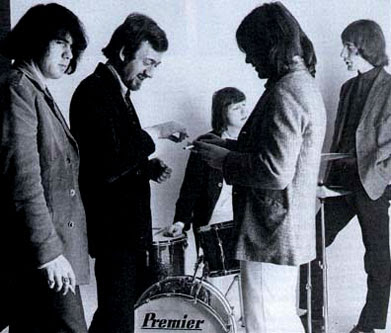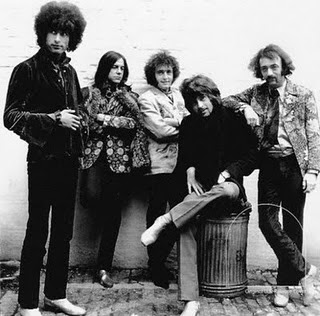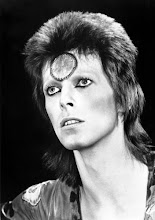
Though never widely known in the United States, The Pretty Things have achieved legendary status in their native Britain after more than 30 years of existence. Through sheer tenacity the band has survived numerous career missteps and line-up changes to enjoy a creative upswing in the late 1990s. Initially notorious for their raw R&B sound and wild off-stage antics, The Pretty Things went on to record an impressive, if often overlooked, body of work that compares favorably with that of their British Invasion rock peers. Among other things, they are credited with inspiring the raw garage rock sound of the mid-sixties and with releasing the first ever rock opera on LP.

The Pretty Things trace their origins back to Sidcup Art College in Kent, England, where singer Phil May and guitarist Dick Taylor took part in lunchtime jam sessions. Another participant was guitarist Keith Richards, who recruited Taylor as a member of Little Boy Blue & the Blue Boys, an early version of the Rolling Stones. Rather than stick with the Stones, Taylor decided to form his own group in 1963 with May, recruiting rhythm guitarist Brian Pendleton, bassist John Stax and drummer Vivian Prince to complete the line-up. Taking their name from R&B pioneer Bo Diddley's song "Pretty Thing," the group took its place beside the Stones, the Animals, the Yardbirds and other young R&B-inspired British combos of the era.

The Pretty Things began to play venues around London and quickly attracted attention. Besides their raucous sound, the band became notorious for their unruly behavior and unkempt appearance. From the start, the band's music was more raw and aggressive than that of their peers. "What we wanted was something for a new generation, some musical identity," said May in a 1999 interview with Discoveries. "We'd found the music, and when we started playing it at the art school, that became our music. We weren't trying to be disrespectful to it, just do it our way. It was almost like thrash R&B. It was faster, but it had to be faster."

Signing a recording contract with Fontana Records, The Pretty Things released their debut single "Rosalyn" in June 1964. This hard-charging tune reached number 41 on the British singles charts. That single paved the way for the band's follow-up release, "Don't Bring Me Down," a number ten hit later that year. Their debut album, The Pretty Things, was released in 1965 and rose to number six on the British album charts.

Controversy surrounded The Pretty Things, even as they performed to ecstatic audiences in Britain and continental Europe. The band's fondness for wrecking hotels and smashing equipment led to their being blacklisted from numerous venues even being barred from entering Australia and New Zealand. Perhaps the most outrageous member was drummer Prince, who left the band in 1965 after a fight aboard an airplane in Australia resulted in bad publicity.

Get The Picture, the band's second album, was released in late 1965. Featuring more original material than their debut album, the album veered away from R&B and towards a more acoustic rock sound. Though it contained the British hit "Midnight To Six Man," the album was not successful. Line-up changes followed, with Wally Allen replacing Stax on bass and John Povey added on keyboards. The Pretty Things tried again in 1967 with Emotions, a more mature effort that emphasized acoustic guitar and vocal harmonies. Unfortunately, the band felt that the album was marred by string arrangements added without their approval. The album failed to generate much interest, and the Pretty Things parted ways with Fontana soon after its release.

The Pretty Things' next album, S.F. Sorrow, appeared on the Harvest label in Britain in late 1968. Based on a short story by May and recorded over a 18-month period, the album is considered to be the first true rock opera. Held together by narration, the interrelated songs featured psychedelic effects that were a far cry from the band's R&B roots. Bad luck plagued the band once again, however. By the time S.F. Sorrow was released in the United States on the Motown distributed Rare Earth label in 1969, The Who had already released their own rock opera Tommy. As a result The Pretty Things were regarded as imitators rather than innovators, and S.F. Sorrow died in the marketplace.

In late 1969, Taylor exited the band, leaving May as the remaining original member. With Victor Unitt brought in on guitar, the Pretty Things released Parachute in 1970. Continuing the band's experimental streak, this sonically diverse work was named Record of the Year by Rolling Stone. Sales of Parachute were disappointing, and the band's fortunes seemed to be at a low ebb. In June, 1970 they broke up, only to reform not long after wards with May at the helm once again. This new line-up released Freeway Madness on Warner Brothers in 1972, again to limited response.

Matters began to improve when heavy metal superstars Led Zeppelin took an interest in the Band. Signing with Zeppelin's Swan Song label the band ventured into a more commercially viable hard rock sound. Released in 1974, Silk Torpedo reflected this direction. Such songs as "Joey" and "Singapore Silk Torpedo" gained FM airplay, while lengthy U.S. tour helped to raise their profile further. But their next Swan Song release, 1976's Savage Eye, failed to perform as well as its predecessor. Distention within the band's ranks led May to quit later that year, which brought The Pretty Things to an end for the second time. May went on to lead a band called the Fallen Angels, while the remaining members continued on as Metropolis. Neither project attracted much interest.

In 1980, May and Taylor rejoined forces to launch The Pretty Things yet again. The no-frills sound and jittery rhythms of new wave rock influenced the resulting Warner Brothers album, Cross Talk. "With Cross Talk, we just wanted to make a record that we could stand up and play, so there was no clever production," May told Discoveries. "So it was slimmed-down, just a straightforward bunch of songs." Despite this attempt to keep up with the times, the album didn't find a large audience. However, the renewed partnership of May and Taylor held together throughout the 1980s, resulting in sporadic live shows and a number of recordings with a changing roster of band mates.
With the help of manager and sometime drummer Mark St. John, The Pretty Things worked to acquire legal rights to their old recordings. By the late 1990s, they had regained ownership of their first five albums, which were reissued through the British label Snapper. At the same time, the 1966 edition of the group May, Taylor, John Povey, Skip Allen and Wally Waller had re-formed and was actively recording and performing. One highpoint was a performance of S.F. Sorrow in its entirety at Abbey Road Studios in September, 1998, broadcast live over the World Wide Web and later released on CD as Resurrection.

All of this activity served as a lead up to the March 1999 release of ...Rage Before Beauty, a CD of new recordings that was praised by critics as a strong return to form. In reviewing the album for Rolling Stone, critic David Fricke noted that "the [Pretty Things] revisit the Bo Diddley beat and recount old war stories the same way they lived 'em with pride, without apology."

Members include Skip Alan, (joined, 1965), drummer; John "Twink" Alder, (joined, 1968), bass player; Wally Allen, bass player; Stuart Brooks, (joined, 1971), bass player; Gordon Edwards, (joined 1971),guitar player; keyboard player; Frankie Ford, (joined, 1998), guitar player; Phil May, vocalist; Brian Pendleton, guitar player; John Povey, keyboard player; Vivian Prince, (joined, 1964),drummer; John Stax, bass player; Dick Taylor, guitar player, vocalist; Peter Tolson, (joined, 1970), guitar player; Victor Unitt, guitar player.
Various Live Videos of The Pretty Things
Pretty Things - Blokker Festival Holland Live Video 1965
The Pretty Things - Midnight to Six Man Live Video (1966)
The Pretty Things - Raining in my Heart Live Video (1966)
The Pretty Things - LSD Live Video (1966)
Wiki info can be found here --> http://en.wikipedia.org/wiki/Pretty_Things
Rock On Music Lovers!!
-Stereo
If you liked this article then make sure you subscribe to the feed via RSS It's Free. You can also follow me on Twitter too!
Check out the Retro Rebirth Design Catalog


No comments:
Post a Comment